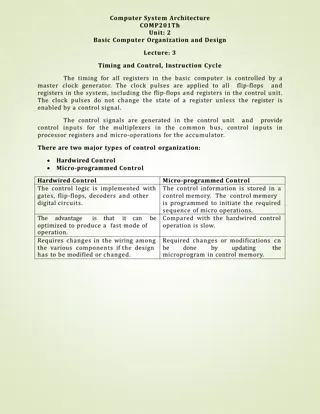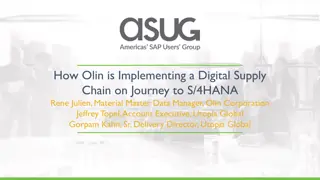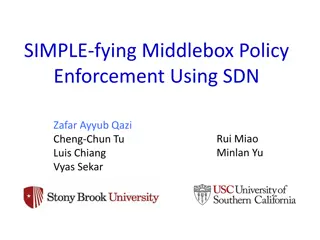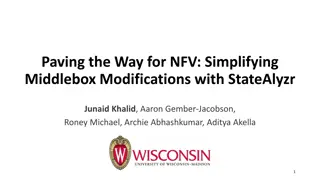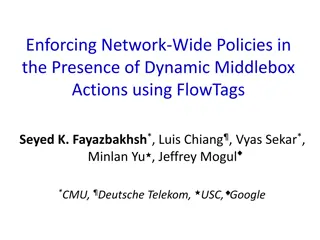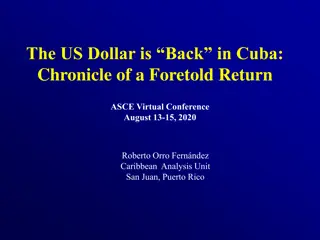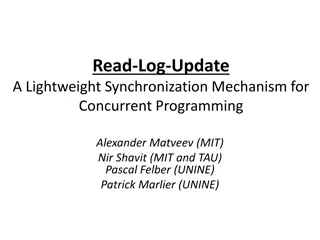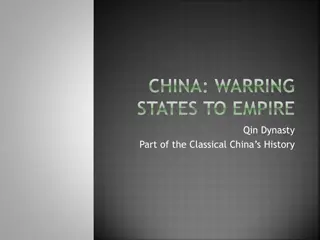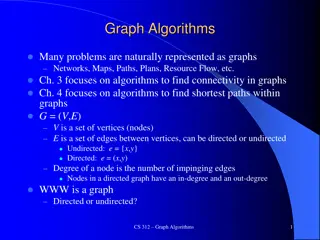Challenges in Unifying Control of Middlebox Traversals
This research delves into the challenges faced in unifying control of middlebox traversals and functionality within enterprise networks. It discusses the importance of middleboxes, deployment scenarios, enforcing desired traversals, and configuring middleboxes. The study emphasizes the need for a unified control system to manage middleboxes efficiently and mitigate network complexities.
Download Presentation

Please find below an Image/Link to download the presentation.
The content on the website is provided AS IS for your information and personal use only. It may not be sold, licensed, or shared on other websites without obtaining consent from the author.If you encounter any issues during the download, it is possible that the publisher has removed the file from their server.
You are allowed to download the files provided on this website for personal or commercial use, subject to the condition that they are used lawfully. All files are the property of their respective owners.
The content on the website is provided AS IS for your information and personal use only. It may not be sold, licensed, or shared on other websites without obtaining consent from the author.
E N D
Presentation Transcript
Aaron Gember, Theophilus Benson, Aditya Akella University of Wisconsin-Madison CHALLENGES IN UNIFYING CHALLENGES IN UNIFYING CONTROL OF CONTROL OF MIDDLEBOX TRAVERSALS AND TRAVERSALS AND FUNCTIONALITY FUNCTIONALITY MIDDLEBOX
Components of Enterprise Networks Middleboxes make up 40% of the network devices in large enterprises with over 200K hosts1 Enterprises spent on average over1 million dollars over the last 5 years to acquire middleboxes1 A Survey of Enterprise Middlebox Deployments, Justine Sherry and Sylvia Ratnasamy, 2012 2
Importance of Middleboxes Additional component traffic passes through for examination and/or modification Not a connection endpoint Not responsible for path selection Ensure security Optimize performance Facilitate remote access 3
Deploying Middlebox Topologies 1) Determine objectives conceptual 2) Select middleboxes, and ordering logical Flow Logger HTTP IDS Select traffic to examine 3) Plan wiring and network config physical 4
Deployment Scenarios Monitor all paths or specific link On-path vs. Off-path Enforcing traversals Physical chokepoint: wiring inline Logical chokepoints: routing hacks Software defined networking (SDN) 5
Enforcing Desired Traversals Brittle networks: choke points Single point-of-failure With SDN, still difficult to expand need control over middlebox to expand Limited flexibility Unable to differentiate based on traffic type Difficult to expand 6
Configuring Middleboxes Infrastructure dependence Distinct language for each vendor Hard to migrate between vendors and network devices Need unified control over middleboxes 67% of the outages are caused by misconfiguration of these middleboxes1 Topology dependence Tied to servers on path prevents mobility of server and middleboxes A Survey of Enterprise Middlebox Deployments, Justine Sherry and Sylvia Ratnasamy, 2012
Benefits of Unification Easier to verify middlebox configuration Easier to migrate between infrastructure Automation leads to flexibility Implement energy saving Implement bottleneck detection and scaling
Centralized Unified Control High level Objectives Control Plane Physical Infrastructure Configures physical infrastructure Routers + Switches: OpenFlow + NOX Middleboxes: ??????
Composing Middlebox Topologies 1) Operator specifies logical topology Flow Logger HTTP IDS 2) Control plane determines path 10
Assumptions Middlebox deployments are based on high level objectives A network of SDN switches Programmatic control over network
Challenges Abstractions for specifying high level constraints Simple yet flexible and powerful Oblivious to the separation between middleboxes and routers. Control Plane Control Plane Common middlebox interface Extensible support new middleboxes Support for vendor specific functionality
Strawman for Abstracting Configuration Basic middlebox functionality Examine Transform Forward Middleboxes should expose: Ways to examine and match packets; e.g., regular-expression on payload, IP headers Transformations supported; e.g., encryption Way to forward; e.g., SSL tunnel, IP
Challenges of Considering Underlying Infrastructure Map constraints to physical infrastructure. Configure physical infrastructure Re-adjust configuration to reflect dynamics Network topology, middlebox features, and network load
Strawman for Considering Underlying Infrastructure LP that matches constraints to exposed MB functionality Minimize latency (# of links) or Minimize resource utilization (# of MBs) Subject to high level constraints Input to LP High level goals Functionality supported by Middleboxes Network topology
State-of-the-Art SDN, Policy-Switch, CloudNaaS Flexible interposition of middlebox No control over configuration Difficult to setup rules for flows without knowledge of middlebox transformations MIDCOM Specify which traffic traverses a middlebox Doesn t support specification of functionality
Summary Discussed challenges of deploying middleboxes Enforcing traversals Configuration management Described outline for unified control Presented advantages and challenges





